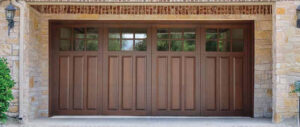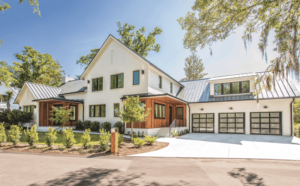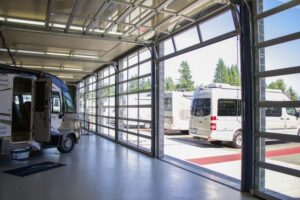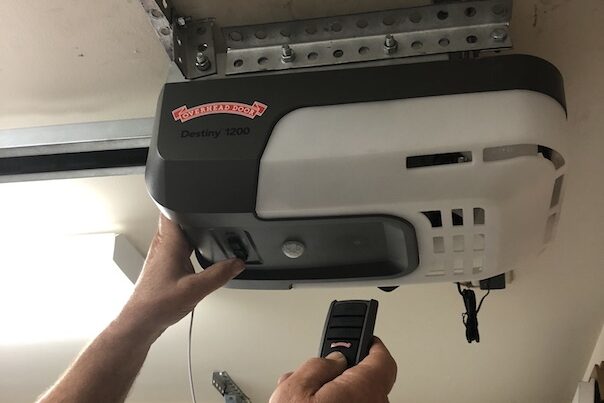If you’re looking into garage door parts, you’ve probably run into a situation where something’s not working quite right. Maybe the door is making strange noises, not opening smoothly, or has stopped working altogether. While we don’t sell individual garage door parts here at Overhead Door Company of Bellingham, we’re happy to break things down so you know what you’re dealing with—and when to call in the pros.
Garage doors are made up of several key components that all work together to keep your door operating smoothly. Here are the most common ones:
- Springs: These do the heavy lifting. Torsion springs sit above the door, and extension springs run along the sides. They’re under serious tension and should only be handled by professionals.
- Cables: These work with the springs to lift and lower the door. If they snap or fray, the door could fall.
- Rollers: Small wheels that run along the track, helping the door glide open and shut.
- Tracks: Metal rails that guide the door’s movement up and down.
- Hinges: Allow the door panels to bend as the door opens and closes.
- Panels: The actual sections that make up the door’s face.
- Weatherstripping: Found along the bottom and sides of the door, it keeps drafts, dirt, and water out.
- Garage Door Opener: The motorized system that opens and closes your door by remote control or wall button.
- Drums: Located near the top of the door on either side, they help wind and unwind the cables attached to the springs.
- Bearing Plates: These support the torsion system and keep everything aligned.
- Center and End Brackets: They hold the torsion bar and allow it to spin freely.
Each part has a job, and if one goes bad, the whole door can start acting up.
How Many Turns Does My Garage Door Spring Need?
This is a question best left to the pros, because garage door springs are incredibly dangerous when handled wrong. That said, the number of turns depends on the height of your garage door. A typical 7-foot-tall door usually requires about 7.5 full turns on a standard torsion spring. But again—don’t try to do this yourself. Spring adjustments can cause serious injury without the right tools and training.
Improperly wound springs can also lead to a door that won’t stay up or crashes down quickly, putting your safety and property at risk. If you suspect spring issues, let a certified technician handle it.
Do Garage Door Openers Go Bad?
Yes, they can. Like any mechanical device, garage door openers have a lifespan. On average, a garage door opener lasts 10 to 15 years, depending on how often you use it and how well it’s maintained. Signs your opener might be going bad include:
- Strange noises
- Inconsistent operation
- Remote or wall switch doesn’t work
- Door reverses for no reason
- Intermittent response
- Sluggish or slow-moving door
Sometimes it’s a simple fix—like replacing the batteries in your remote or resetting the system. Other times, the opener’s internal components, like the circuit board or gear system, may be wearing out.
You might also notice an increase in your opener struggling to lift the door. That could be a sign the door’s balance is off or the motor is losing strength. Either way, it’s a good idea to get it checked.
What Is the Toughest Part of Installing a Garage Door?
The hardest part of installing a garage door is dealing with the springs. These tightly wound components are essential for the door’s balance and movement, but they’re also the most dangerous. If released incorrectly, they can cause serious injury or property damage.
Other tricky parts include:
- Aligning the tracks correctly so the door runs smoothly
- Balancing the door weight with the right type of spring
- Ensuring the opener is properly synced with the door
- Mounting the torsion system accurately and safely
- Adjusting limit settings on the opener to avoid slamming or jamming
Garage doors can weigh hundreds of pounds, and without the right support or tools, installation can quickly become unsafe. Most people hire professionals because the process requires precision, strength, and experience.
Why It’s Smart to Call the Experts
Even though DIY fixes might seem tempting, garage door systems are more complex (and more dangerous) than they look. The risk of injury when working with parts like springs and cables is high, and an incorrect repair can lead to future damage or even a total failure of the door.
Professionals know how to:
- Accurately diagnose problems
- Replace or adjust parts safely
- Make sure your door is balanced and aligned
- Test opener functionality
- Check safety mechanisms like sensors and auto-reverse features
Not only do they save you time, but they also prevent you from risking your safety or voiding warranties.
What Happens When Garage Door Parts Wear Out?
When individual parts start to fail, here’s what you might notice:
- Worn springs: Loud bangs, door won’t open all the way, or gets stuck
- Frayed cables: One side of the door hangs lower
- Cracked rollers: Noisy movement or jerky operation
- Loose hinges: Rattling sound or panel misalignment
- Damaged panels: Cosmetic dents or compromised structure
- Malfunctioning opener: Door doesn’t move or behaves erratically
One small issue can turn into a big repair if left unchecked. That’s why regular maintenance matters.
Simple Ways to Keep Your Garage Door Healthy
You can keep your garage door running smoothly by staying on top of basic maintenance tasks:
- Listen for unusual noises when the door is moving
- Inspect hardware every few months (rollers, cables, and hinges)
- Lubricate moving parts with a garage door spray (not WD-40!)
- Test the balance of the door by disconnecting the opener and lifting it halfway
- Check the auto-reverse feature using a roll of paper towels under the door
If anything seems off, it’s best to reach out to a professional.
Common Garage Door Repairs (We Handle These!)
- Broken springs
- Snapped cables
- Misaligned tracks
- Loud or unresponsive openers
- Panel replacements
- Sensor problems
Sometimes a garage door problem looks simple but actually has a complex cause. Don’t stress—we’ll figure it out and get things back on track.
Why Garage Door Parts Matter
Every little piece of your garage door has an important job. Think of it like a team—if one member stops pulling their weight, the whole system suffers. That’s why keeping everything in good shape isn’t just about convenience, it’s about safety.
A well-functioning garage door helps:
- Keep your home secure
- Protect your car and belongings
- Insulate your garage from weather
- Maintain curb appeal
- Prevent costly repairs down the road
What are garage door parts called?
Garage door parts include springs, cables, rollers, tracks, hinges, panels, weatherstripping, openers, drums, bearing plates, and brackets—each with its own role in keeping the door working properly.
How many turns does my garage door spring need?
A standard 7-foot door usually requires about 7.5 full turns on a torsion spring, but handling this yourself is dangerous—call a pro instead.
Do garage door openers go bad?
Yes, garage door openers typically last 10–15 years. If yours is noisy, inconsistent, or unresponsive, it might be time for a repair or replacement.
What is the toughest part of installing a garage door?
The hardest part is working with the springs—they’re under high tension and can be very dangerous without proper tools and training.
Call (360) 734-5960 now to schedule a service or inspection.
Need fast help? Contact us for support or request a service online—let’s get your garage door working like new again!





